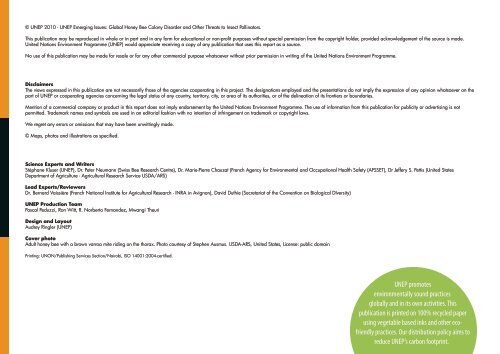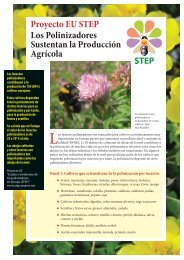Global Honey Bee Colony Disorder and Other Threats to Insect
Global Honey Bee Colony Disorder and Other Threats to Insect
Global Honey Bee Colony Disorder and Other Threats to Insect
You also want an ePaper? Increase the reach of your titles
YUMPU automatically turns print PDFs into web optimized ePapers that Google loves.
© UNEP 2010 - UNEP Emerging Issues: <strong>Global</strong> <strong>Honey</strong> <strong>Bee</strong> <strong>Colony</strong> <strong>Disorder</strong> <strong>and</strong> <strong>Other</strong> <strong>Threats</strong> <strong>to</strong> <strong>Insect</strong> Pollina<strong>to</strong>rs.This publication may be reproduced in whole or in part <strong>and</strong> in any form for educational or non-profit purposes without special permission from the copyright holder, provided acknowledgement of the source is made.United Nations Environment Programme (UNEP) would appreciate receiving a copy of any publication that uses this report as a source.No use of this publication may be made for resale or for any other commercial purpose whatsoever without prior permission in writing of the United Nations Environment Programme.DisclaimersThe views expressed in this publication are not necessarily those of the agencies cooperating in this project. The designations employed <strong>and</strong> the presentations do not imply the expression of any opinion whatsoever on thepart of UNEP or cooperating agencies concerning the legal status of any country, terri<strong>to</strong>ry, city, or area of its authorities, or of the delineation of its frontiers or boundaries.Mention of a commercial company or product in this report does not imply endorsement by the United Nations Environment Programme. The use of information from this publication for publicity or advertising is notpermitted. Trademark names <strong>and</strong> symbols are used in an edi<strong>to</strong>rial fashion with no intention of infringement on trademark or copyright laws.We regret any errors or omissions that may have been unwittingly made.© Maps, pho<strong>to</strong>s <strong>and</strong> illustrations as specified.Science Experts <strong>and</strong> WritersStéphane Kluser (UNEP), Dr. Peter Neumann (Swiss <strong>Bee</strong> Research Centre), Dr. Marie-Pierre Chauzat (French Agency for Environmental <strong>and</strong> Occupational Health Safety (AFSSET), Dr Jeffery S. Pettis (United StatesDepartment of Agriculture - Agricultural Research Service USDA/ARS)Lead Experts/ReviewersDr. Bernard Vaissière (French National Institute for Agricultural Research - INRA in Avignon), David Duthie (Secretariat of the Convention on Biological DIversity)UNEP Production TeamPascal Peduzzi, Ron Witt, R. Norber<strong>to</strong> Fern<strong>and</strong>ez, Mwangi TheuriDesign <strong>and</strong> LayoutAudrey Ringler (UNEP)Cover pho<strong>to</strong>Adult honey bee with a brown varroa mite riding on the thorax. Pho<strong>to</strong> courtesy of Stephen Ausmus. USDA-ARS, United States, License: public domainPrinting: UNON/Publishing Services Section/Nairobi, ISO 14001:2004-certified.




